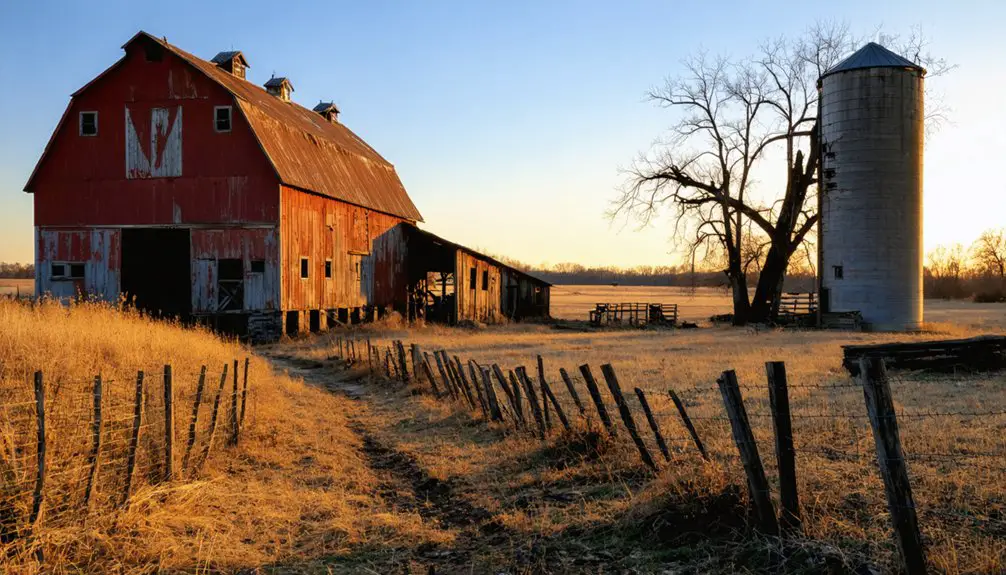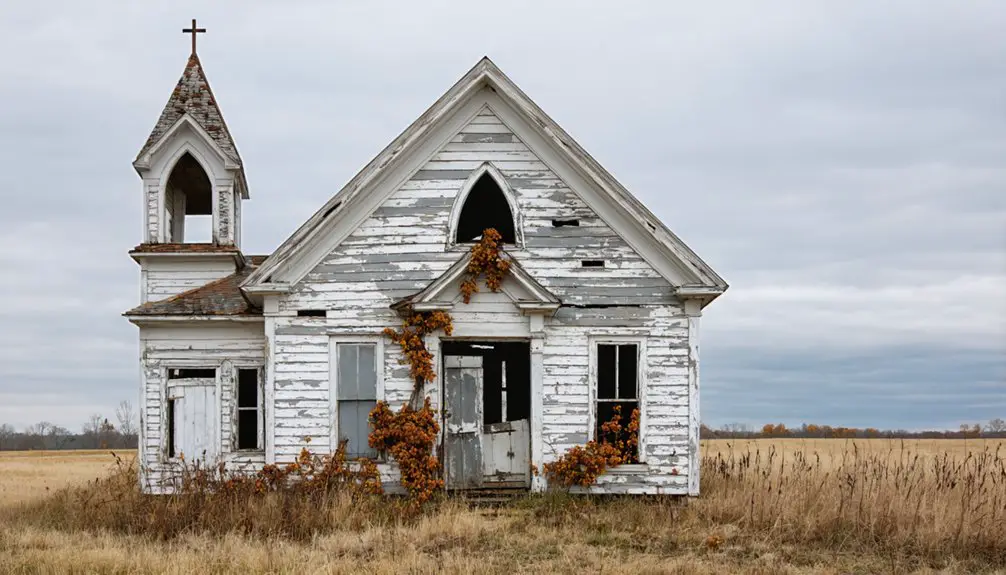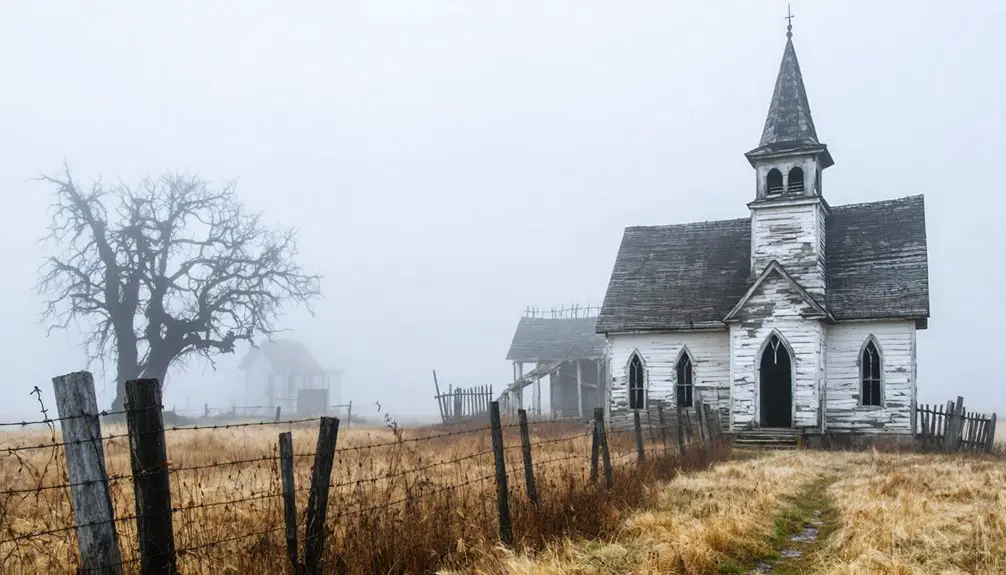You’ll find Howell’s dramatic story in Missouri’s Ozarks, where it transformed from a humble settlement into a booming railroad town in the 1880s. The Kansas City, Fort Scott & Memphis Railroad triggered explosive growth, with the population soaring from 351 to over 2,000 residents. The town thrived on timber harvesting until the virgin pine forests were depleted around 1900. By the mid-20th century, following the Great Depression and Dust Bowl, this once-prosperous community had faded into a ghost town. The scattered foundations and remnants tell a deeper tale.
Key Takeaways
- Howell was a railroad boomtown that flourished in the 1880s due to the Kansas City, Fort Scott & Memphis Railroad expansion.
- The town’s economy peaked during timber industry operations but declined after virgin pine forests were depleted around 1900.
- Economic hardship during the Great Depression and Dust Bowl of the 1930s drove many residents away from the area.
- The U.S. Army’s 1941 acquisition of land for the Weldon Spring Ordnance Works forced remaining residents to relocate.
- Historical remnants include railroad station foundations, cemetery plots, and deteriorating mill structures along former rail lines.
The Birth of a Railroad Boomtown
When the Kansas City, Fort Scott & Memphis Railroad laid tracks through Howell County in the early 1880s, it transformed a quiet rural region into a bustling network of boomtowns.
The South Missouri Land Company made a strategic move by relocating its headquarters to Willow Springs in 1881.
You’d have witnessed the railroad expansion reach Burnham and Horton by 1881, followed by Willow Springs in 1882 and West Plains in 1883. Workers earned between $1.50 and $3.00 per day to help construct the rail lines.
The economic impact was immediate and dramatic. You could’ve seen West Plains’ population explode from 351 to over 2,000 residents in just a decade.
Towns like Horton, originally called Drew, sprang up along the tracks, while established settlements like Willow Springs and Cabool evolved into major lumber and transportation hubs.
Everywhere you looked, new sawmills, warehouses, hotels, and stores clustered near the rail depots, transforming the landscape as settlers and workers poured into these promising new communities.
Timber Industry’s Golden Era
As the KCFS&M Railroad pushed through Howell County in the early 1880s, it opened access to vast virgin pine forests that would transform the region’s economy.
You’d find timber harvesting operations first concentrating in the northwest, near Willow Springs, where the Southern Missouri Land Company established its headquarters in 1881.
Railroad expansion soon stretched eastward with the Current River Line to Grandin, enabling Missouri Lumber and Mining Company to exploit their 100,000 acres of timberland.
The eastward advance of rail lines unlocked vast forests, letting Missouri Lumber and Mining Company tap into their extensive timber holdings.
You could’ve witnessed bustling mill towns springing up along the tracks, with monthly payrolls reaching $3,000. At places like White’s Mill, 125 workers processed up to six million board feet annually.
The steam-powered mills revolutionized lumber production capabilities throughout the region.
The industry flourished through strategic railroad partnerships, though this golden era would eventually fade as virgin pine reserves depleted around 1900.
Similar to the government acquisition of Howells Prairie in 1940, the expansion of industry dramatically transformed local landscapes and communities.
Daily Life in Early Howell
Life in early Howell centered around a self-sustaining community where settlers balanced farming, hunting, and gathering to survive the Ozark region’s challenges.
Your daily routines would’ve involved working the land, processing food at local mills, and preserving supplies for winter through smoking and salting. You’d find yourself living in simple log cabins built from local timber, while community gatherings often took place in shared spaces like homes or brush arbors before proper buildings were constructed. Led by Josiah Howell’s family, the settlement grew steadily after their arrival in the 1830s. Settlers often supplemented their food supplies by collecting wild honey from the abundant bee colonies in the area.
- Religious services served as the backbone of social life, bringing settlers together for worship and fellowship.
- Schools started in modest subscription-based settings, where your children would learn alongside their neighbors.
- Community decisions and governance reflected the traditions settlers brought from their original homes.
Notable Pioneer Families
The Howell family’s prominence in southern Missouri began with patriarch Josiah Howell, whose settlement efforts led to the county bearing his name.
You’ll find his legacy intertwined with other notable pioneer families who shaped the region’s early development. While Josiah and his family members rest beneath the old Arcade Hotel site, their contributions live on through the county’s identity.
Other influential pioneer families made lasting marks too. “Uncle Dick” Smith established his homestead in Barn Hollow, while Isaac Winningham secured 160 acres in the 1850s. In 1840, Josiah Howell purchased the Adams Improvement land. The county later established a poor farm to support residents who had nowhere else to go.
The Barnetts brought spiritual leadership through Nathaniel’s Baptist ministry, and Robert Sharp’s family legacy includes donating land for education.
Together, these families’ pioneering spirit created the foundation for today’s community through their schools, farms, and places of worship.
Religious and Educational Foundations
Pioneer families’ deep religious convictions shaped Howell’s early spiritual landscape, beginning with informal worship services in homes and brush arbors. The Antioch Church, established around 1894, became a cornerstone of the church community despite initial location disputes between “Buck Snort” and “Dishrag” factions. The area’s virgin pine forests provided building materials for the town’s earliest churches.
Religious institutions played a crucial role in education evolution, with congregations sponsoring early schools and sharing resources.
- Churches served as essential community centers, where settlers gathered for worship, social events, and mutual support.
- Religious leaders became instrumental in establishing formal educational institutions, moving from shared church buildings to dedicated schoolhouses.
- The intertwined development of religious and educational foundations created lasting impacts on regional culture, even after the town’s decline.
Economic Decline and Abandonment
During Howell’s peak prosperity near the turn of the 20th century, massive timber operations fueled rapid economic growth until the virgin pine forests couldn’t sustain further harvesting.
The economic exploitation by large lumber companies left the town vulnerable when they withdrew, marking the beginning of Howell’s decline.
Similar to the Great Depression that ravaged Missouri’s economy, Howell faced severe economic hardships that crippled local businesses.
You’d have seen the situation worsen during the 1930s Dust Bowl, as severe soil erosion devastated local agriculture and drove farmers away.
The limited infrastructure and isolation of Howell prevented new industries from taking root.
The final blow came in 1940-1941 when the U.S. Army’s acquisition of land for the Weldon Spring Ordnance Works forced community displacement.
This military takeover permanently ended any chance of economic recovery, transforming Howell into a ghost town as residents scattered, leaving behind their once-thriving community.
Historical Landmarks and Remnants
You’ll find remnants of the Kansas City, Fort Scott & Memphis Railroad station foundations marking where Howell’s bustling transportation hub once stood.
The historic Barnett Cemetery, which predates much of the town’s development, contains graves of the area’s earliest settlers and railroad workers who shaped the community’s growth.
Along the former rail line, you can still spot deteriorating structures from the town’s mill operations that once processed timber hauled in by the railroad.
Railroad Station Foundations
Several distinctive railroad station foundations remain scattered throughout Howell County’s ghost towns, marking the once-bustling stops of the Kansas City, Fort Scott & Memphis Railroad.
The railway architecture you’ll find includes standard gauge track foundations, surviving platform structures, and remnants of two-story buildings that once served as company headquarters. These ghost town remnants tell the story of thriving communities like Horton and Burnham, where depots doubled as essential commercial centers.
- Original stone and concrete foundations reveal the strategic placement of stations that connected timber sites to larger markets
- Track beds and railroad ties still visible in the landscape showcase the extensive network that powered local commerce
- Foundation sites of mills and related industries, located nine miles west of Burnham, highlight the railroad’s economic impact
Barnett Cemetery History
Among Howell County’s most enduring historical sites, Barnett Cemetery stands as a tribute to Civil War-era resilience and pioneer spirit. The cemetery’s significance began when local women and young “Uncle Buck” Gunter buried an unknown Union soldier under cover of darkness.
Named after Nathaniel Barnett, a respected Baptist minister and state legislator who lived nearby, the cemetery became a cornerstone of the Peace Valley community.
You’ll find the cemetery near the school in Peace Valley, about four miles south of the post office. These pioneer memorials tell stories of early settlers, religious gatherings, and Civil War impacts.
While many historical structures in Howell have vanished, Barnett Cemetery endures, preserving the legacy of those who shaped this corner of Missouri through digital records and physical monuments.
Remaining Mill Structures
While Howell County’s timber industry once thrived with numerous mill towns in the late 1800s, today’s landscape reveals only scattered remnants of this industrial heritage.
You’ll find most original mill structures have succumbed to natural decay, with only foundations and partial ruins marking their locations. The challenging reality of mill preservation becomes apparent when you explore former sites like Ball’s Mill and Drew/Horton, where vegetation has reclaimed much of the land.
Structure rehabilitation efforts face significant obstacles, as many sites have been repurposed or completely abandoned.
- Stone foundations and machinery remains serve as silent witnesses to the county’s industrial past
- Historic cemeteries and school buildings stand as the most enduring landmarks of these lost communities
- Former mill sites along railroad corridors reveal the vital relationship between transportation and industry
Legacy in Modern Missouri
You’ll find Howell’s legacy preserved through dedicated efforts to document and protect key sites from the former railroad town, though many original structures were lost during the 1941 government acquisition.
Railroad enthusiasts and preservationists have identified potential tourism opportunities centered around the remaining track beds and industrial artifacts that tell the story of Missouri’s wartime transformation.
Local historical societies maintain archives of photographs and documents from Howell’s pre-ghost town era, ensuring future generations can understand how national priorities reshaped this once-thriving community.
Heritage Site Preservation Efforts
Since the 1980s, preservation efforts in Howell, Missouri have focused on balancing environmental safety with historical conservation.
You’ll find extensive heritage conservation initiatives, including the documentation of over 130 historic buildings and the successful cleanup of 1.48 million cubic yards of toxic waste.
Through community engagement, local historical societies and preservation groups have helped secure protective status for 84 buildings eligible for the National Register of Historic Places.
- The Weldon Spring Interpretive Center serves as your gateway to understanding both environmental recovery and local history
- You’re encouraged to explore hiking trails and observation points that connect you to the region’s past
- You’ll discover how grant programs and heritage tourism support the preservation of your community’s architectural treasures
Railroad Tourism Potential
As the historic railroads of Howell County shaped Missouri’s development in the late 19th century, today’s ghost towns and preserved rail corridors offer unique tourism opportunities.
You’ll discover railroad tourism experiences that bring the region’s industrial heritage to life through museums, heritage trails, and interpretive centers. These attractions showcase the dramatic stories of towns like Carson, which thrived along the Kansas City, Fort Scott & Memphis Railroad before fading into history.
You can explore scenic routes once traveled by steam engines, witnessing the challenging topography that tested early railroad engineers.
Local festivals and educational programs highlight the crucial connection between railroads and the area’s timber industry, while heritage rail excursions let you experience firsthand how these iron paths transformed the Ozark landscape.
Frequently Asked Questions
What Indigenous Tribes Originally Inhabited the Howell Area Before Settlement?
You’ll find the Osage were the primary Native Tribes in 1808, while Delaware, Kaw, and Shawnee tribes visited regularly. Their cultural heritage lives on through 1,000+ prehistoric mounds and ancient trails.
How Did the Civil War Specifically Impact Development in Howell?
You’ll find the Civil War devastated local development through guerrilla raids, destroyed farms, and severe economic impacts. Union and Confederate forces disrupted trade routes, displaced residents, and halted community growth.
Were There Any Major Natural Disasters That Affected Howell’s Population?
You won’t find any documented flood impact or tornado history that considerably affected the population. While Missouri faced natural disasters, there’s no evidence of major environmental catastrophes destroying Howell’s community.
What Happened to the Original Railroad Tracks and Infrastructure?
You’ll find the railroad history shows a clear infrastructure decline, as tracks were abandoned after Frisco’s 1902 acquisition. Most rails were removed when road transport increased, leaving only scattered traces today.
Did Any Infamous Outlaws or Criminal Activities Occur in Howell?
You’ll find outlaw legends tied to Jesse James Gang’s activities nearby, with criminal escapades including Missouri’s first peacetime train robbery. Local gunfights and vigilante violence from Bald Knobbers shaped the area’s lawless reputation.
References
- http://www.howellcountynews.com/history/howell-county-ghost-town-several-names
- https://en.wikipedia.org/wiki/List_of_ghost_towns_in_Missouri
- https://www.howellcountynews.com/real-estate-0?page=9
- https://collections.shsmo.org/manuscripts/columbia/C2366/howell-county
- https://www.youtube.com/watch?v=XygKYI_R-1c
- https://mostateparks.com/sites/mostateparks/files/Historic and Architectural Resources of West Plains
- https://www.southernmissourilifestyle.com/history/the-railroad-s-impact-on-southern-missouri
- http://www.howellcountynews.com/history/history-downtown-willow-springs
- https://en.wikipedia.org/wiki/First_transcontinental_railroad
- https://www.nps.gov/parkhistory/online_books/ozar/hrs6.htm



